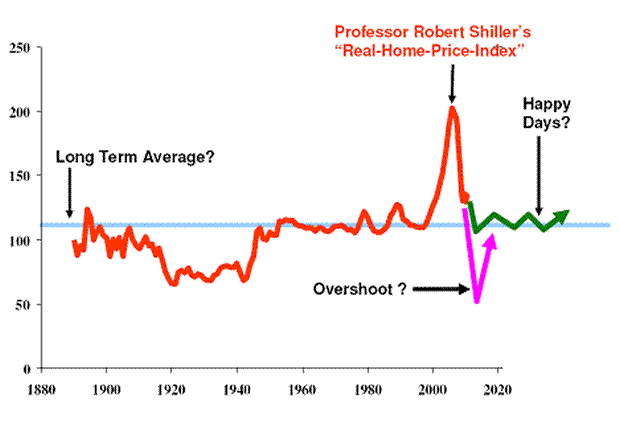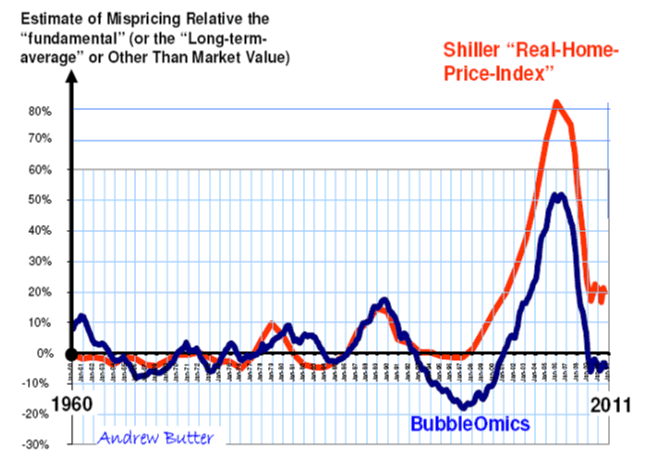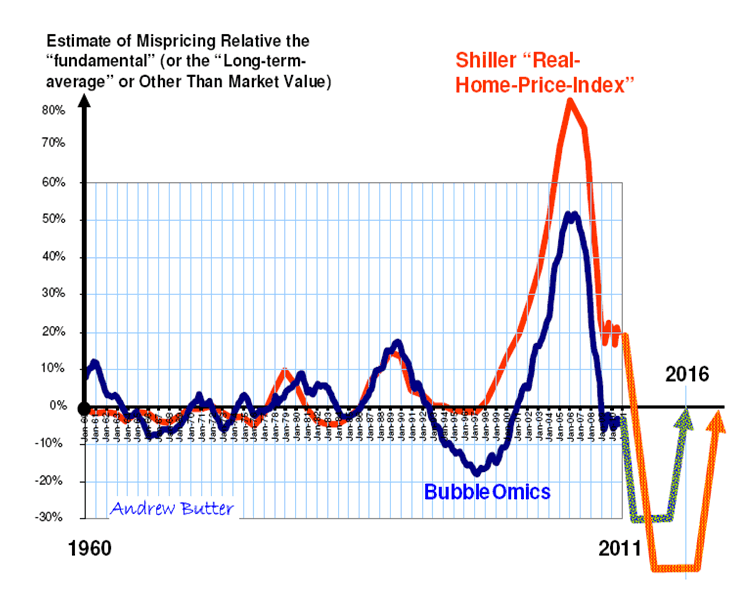If Shiller’s Chart Is Right US Housing Market Has 50% to Fall: BubbleOmics Disagrees
Housing-Market / US Housing Jan 14, 2011 - 10:56 AM GMTBy: Andrew_Butter
 There has been a kind of pause in house price angst in USA over the past year, the “good news” is that “only” one million homes were physically repossessed in 2010 which is about the same as 2009. The bad news is that outside of the temporary respite achieved by “Foreclosure-Gate”, the trend is still up.
There has been a kind of pause in house price angst in USA over the past year, the “good news” is that “only” one million homes were physically repossessed in 2010 which is about the same as 2009. The bad news is that outside of the temporary respite achieved by “Foreclosure-Gate”, the trend is still up.
http://money.cnn.com/2011/01/13/real_estate/foreclosures_2010/index.htm
But foreclosures are still a reality and since the “crunch” started in 2007, a total of three million American families have been kicked out of their homes; that’s a tragedy in itself. Imagine what people would be saying if a terrorist attack had put three million American families on the street?
When will it end, and where?
One of the best-known graphics of the Credit Crunch is Professor Shiller’s chart of “Real Home Prices” which he gets from his house price index (and preceding indexes), adjusted for inflation (using CPI).
Some people say the “Real-Index” is 15% to 20% above the “Long-Term-Average”, and therefore home prices need to drop by that amount before “market clearing” starts to happen, and “things get back to normal”.
I’m sorry to be a little slow here, but surely even a Nobel Prizewinning economist ought to be able to figure out there is something illogical about that notion?
Because if prices only go down to the long-term average, then the long-term-average won’t be the long-term average anymore; for that to stay as the “long-term average”, prices need to go down a lot more, like to about half where they are now; unless of course Ben can get inflation up dramatically, but sadly he does appear to be having a real problem getting it up.

That concept is sometimes acknowledged as the idea that “markets over-shoot”, which is what Bob Farrell was talking about in his 2nd Law.
I’d like to remark at this juncture that Professor Shiller is not saying that house prices in USA are set to drop 50% from where they are now; in fact he is keeping remarkably quiet these days, which could be an Omen in itself.
In any case Shiller has never puts himself out as either a “sage” or a forecaster”, all he did to get his “Real Index” was divide one set of good data by another set of public data, and say “Oops…look at that”! Which was correct, if people had taken Shiller seriously in 2003 none of this would have happened.
So what’s wrong with Shiller’s Chart?
To understand that, you have to understand the question is nothing to do with economics. Which is fortunate because personally I know nothing about economics and I freely admit that until quite recently I thought that Keynes was somehow related to Milton, as in the pretty little town in England called “Milton Keynes”.
To understand what’s happening you have to understand “valuation”, which something that “professional” economists are not the least-bit interested in.
I was educated on that point after I submitted a paper to the esteemed “Journal of Economics & Business”, on the subject of “The Value of Housing in USA”. I got a very nice and polite note back, almost by return, saying that since my paper was about “valuation” and not “economics”, they had decided not to “detain” me by getting it “peer reviewed”, prior to rejecting it.
Notwithstanding that education about what economics isn’t (I’m still a little hazy about what it is), it did occur to me that the general direction of the economy in the USA may perhaps be predicated to a depressingly large degree, on precisely at what juncture house prices stop going down and start to go up again.
If only because that will determine what is the value of all the toxic assets held by banks and financial institutions (and increasingly by the Federal Reserve), and thus determine whether they are solvent or not. As in assets being worth more than liabilities, which is also about “valuation” and thus is not something economists need to worry their pretty little heads about.
The first thing to know about valuation; is that there are two types of value.
1: What you can reasonably expect to sell something for, to someone dumber than you (that’s called “mark-to-market” or “Fair-Value” (as in “fair-play”) by some people).
2: What you can reasonably expect to sell something for, to someone smarter than you (that’s sometimes called “the fundamental”).
What we are talking about here is the second type of valuation, the price at which people, who are smarter than the banks that wrote all those crazy mortgages, are prepared to pay.
To understand where that price is, you need to figure out what is the “fundamental”. That’s because, in history, prices tend to oscillate around the fundamental; in fact by definition, the “fundamental” is the value that prices oscillate around.
So if you have some sort of idea what it is, you can sometimes work out where prices are likely to go in the future, which can sometimes be useful, from time to time.
For example, say you had been a banker writing mortgages in 2006 in USA, and you had known that the price of housing in USA was on average 50% above the “fundamental”, and you were deciding how much money to advance against the collateral of a house.
Then before you wrote a 120% LTV loan to a crack-head with no job, and no chance of getting one (even dealing crack), the thought might have occurred to you that there was a chance that if ever, horror, it became necessary to collect the collateral and to sell it so as to get your money back, and the supply of “dumber than thou” people had dried up, you might find that the amount of money you could get back at the end of the deal, was (a lot) less than the amount of money you had lent.
That of course is a detail Nobel Prizewinning economists are not at all interested in, since they have much grander aspirations than that. They say, “Well who cares? If the bankers lose all their money, we can just print some more for them to gamble with”.
So what’s the “Fundamental” price of housing in USA?
How about this for a “valuation hypothesis”, how about if “fundamental” utility of a house to someone who owns it, is a as a place to live, that is as opposed, for example, to being a gambling chip that you can pawn so as you can “play the markets”.
If that’s right, it follows you can work out the “fundamental” using a modified income capitalization valuation based on the logic that (a) the fundamental utility value (as a proxy for cash-flow) of an owner-occupied house is a constant proportion of nominal GDP, thus per house it’s a constant proportion of nominal GDP divided by the number of houses (b) that the applicable yield (to get to price from cash flow) is an “S” Curve function of the MA of the 30-Year Treasury.
You might disagree with the logic there, and say, “Oh but I don’t see Father Christmas in that algorithm”. What you can’t argue with is that if you plot that valuation model against actual for the past 100 years you get a 98.8% R-Squared.
What that means in plain English is that “valuation model” explains 98.8% of changes in house prices in USA (according to Shiller’s data) over one hundred years.
The next best model I heard of is Shiller’s; that explain 54.2% of the changes. In case you are a Nobel Prizewinning economist, I would like to explain 98.8% is a LOT better than 54.2% as validation of a valuation model.
The long-explanation of the logic for that is at:
http://www.marketoracle.co.uk/Article6250.html
This is my analysis recently up-dated compared to Shiller, with the “Y” axis an estimate of the percentage degree of over and under-pricing (so 100% on the “Y” axis means prices are double the “fundamental” and -50% means they are half).

So what’s different?
Shiller’s model is based on the idea that house prices should track CPI, which is logical, except:
(A): Twenty-five percent or so of CPI is the cost of “shelter” so that’s not an independent variable for figuring house prices.
(B): Starting 1987 the US Government began to mess around with how CPI was calculated; the biggest “adjustment” was “owner’s equivalent of rent”, which “assumes” (a) the world is flat (b) the utility cost of 90% of the housing market (by value) can be worked out from the other 10%. If you can’t understand how stupid that is, I recommend you instantly apply for a job with some US government department, as an economist. Most (sane) people agree that from that point CPI in USA was under-reported.
That would explain why Shiller’s “Real-House-Price-Index” is off the mark in the 2006 bubble.
Also, an interesting point, if the mispricing now is as calculated here (about 5% under), that suggests that now the cumulative misrepresentation of CPI since 1987 is a factor of 1.26 meaning that on average CPI was under-reported by about 2.36% a year since 1992 which is when the lines started to diverge.
I’m not sure that’s something of interest to Nobel-prizewinning economists? Probably not, the consensus appear to believe that measurement of inflation in USA is something that magically occurs under the Divine Supervision of 2,000 PhD economists deep in the vaults of the Bureau of Labour, and that their pronouncements could not possibly be wrong.
Next?
The BubbleOmics line in that chart is an update with minor “tweaking” of an analysis which was initially done in March 2008, and which I confess I have not revisited except to make “back-of-the-envelope” estimates.
This updated analysis was a bit of a surprise. Previously I’d thought the “bust” had about bottomed, now I’m pretty sure that the bust has not been fully expressed, held back by frantic efforts of the US administration to save the moronic bankers from the folly of their collective lunacy from 2002 to 2007; extending and pretending and pretending and extending.
As if putting your head in the sand works long-term! But if you have the power to blow up dots walking across the landscape on the other side of the world that you suspect are evil-doers plotting the destruction of America, surely you have the power to manipulate markets in your back-yard? As Churchill said, “power corrupts; absolute power corrupts absolutely”.
The problem is that governments are fleas on the back of the elephant of markets, sometimes they can influence events, but like King Canute found out, eventually, the tide comes in.
This is what BubbleOmics says will happen; basically at some point something has to give, and prices need to get down to where market clearing of all the mal-investments of 2003 or so to 2006, get washed out of the system. The alternative is for the government to keep trying to bail-out the incoming tide, and even in America, there is a limit to how much the government can borrow or the Fed can print, to bail out the morons on Wall Street.

Let’s say with “foreclosure-gate” and more efforts by the US Administration to delay the day of reckoning, keeps the “uncomfortable insanity” of the marketplace at bay until 2013, and let’s say that the 30-year stays more or less at what it is now, and nominal GDP growth is 5% (inflation is always an option).
Then if the “BubbleOmics” valuation model is right, house prices will bottom 15% below where they are now, sometime in 2013.
The good news, I suppose, is that’s not 50% below where they are now, which is what the logical conclusion of Professor Shiller’s analysis says.
By Andrew Butter
Twenty years doing market analysis and valuations for investors in the Middle East, USA, and Europe; currently writing a book about BubbleOmics. Andrew Butter is managing partner of ABMC, an investment advisory firm, based in Dubai ( hbutter@eim.ae ), that he setup in 1999, and is has been involved advising on large scale real estate investments, mainly in Dubai.
© 2010 Copyright Andrew Butter- All Rights Reserved
Disclaimer: The above is a matter of opinion provided for general information purposes only and is not intended as investment advice. Information and analysis above are derived from sources and utilising methods believed to be reliable, but we cannot accept responsibility for any losses you may incur as a result of this analysis. Individuals should consult with their personal financial advisors.
Andrew Butter Archive |
© 2005-2022 http://www.MarketOracle.co.uk - The Market Oracle is a FREE Daily Financial Markets Analysis & Forecasting online publication.



